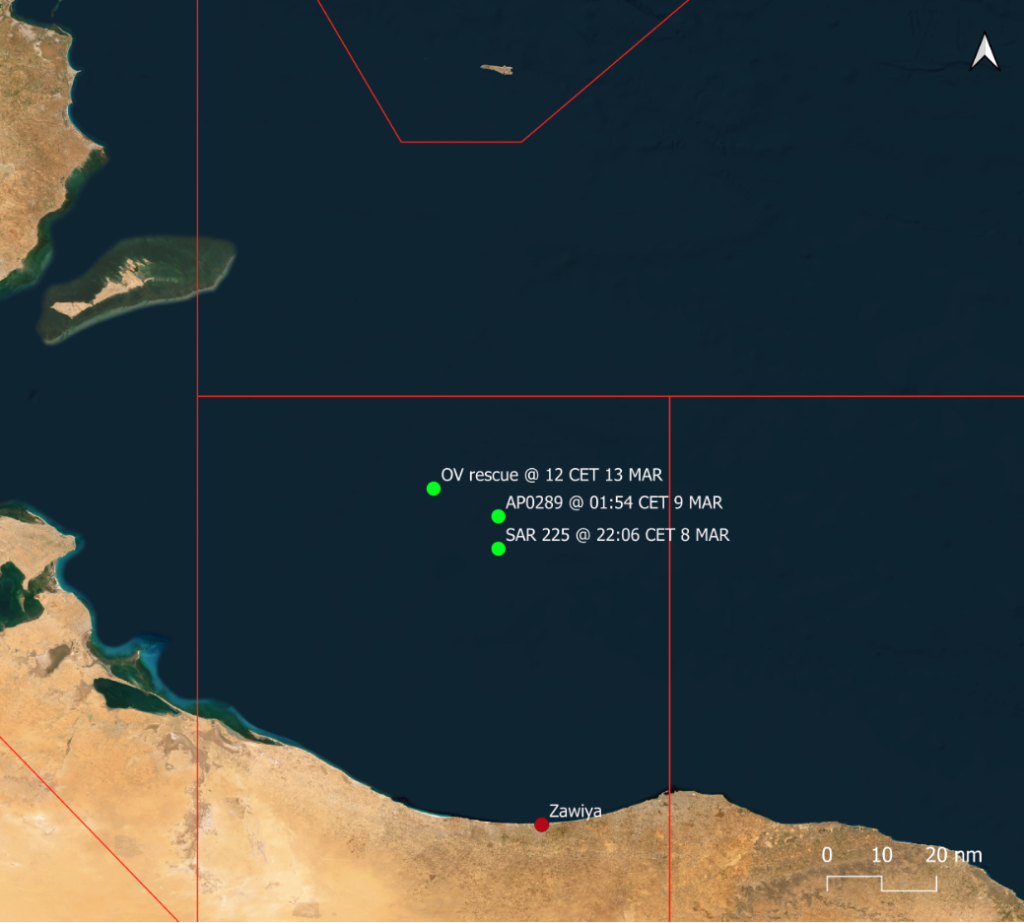
Photo: Alarm Phone
On the 13th of March 2024 the rescue vessel Ocean Viking rescued 25 people on a black rubber boat in international waters. According to the survivors, they had spent nearly one week at sea – adrift and without orientation.
During that time many people perished and are now missing.
The #OceanViking team evacuated 25 people from a drifting rubber boat spotted via binoculars in the Libyan SRR. A medical mass casualty plan had to be initiated, to care for the survivors found in extreme vulnerable physical and mental health. (1/2) pic.twitter.com/vRMrV3q5Rg
— SOS MEDITERRANEE (@SOSMedIntl) March 13, 2024
After a relative informed the Alarm Phone that they recognized a family member on the pictures of the rescue published by SOS Mediterranée, we realized that it was the same boat we had alerted authorities about four days earlier. Despite authorities knowing about the people in distress for several days – via our alerts but also air surveillance, no rescue operation was initiated. This non-assistance led to the death of around 60 people.
Together with families of the missing, we demand information about the steps taken by the competent EU SAR authorities and agencies to proactively search for people in distress and launch a rescue operation to prevent this huge loss of life.
Chronology of non-assistance
At 06:13 CET on the 9th of March 2024, a relative called the Alarm Phone to inform about 85 people on a wooden boat in distress which left from Zawiya in Libya. Among them were 4 women, and a 2 year old boy. The relative gave us a GPS position: N 33°54, E 012°35 at 01:54 CET on 09.03.2024, which is about 66 nautical miles/ 120 kilometers north of Zawiya. We assigned the case number AP0289.
Alarm Phone informed authorities at 6:41 CET via email. In our communication we initially stated the boat was wooden, but then subsequently received and shared more accurate information about the type of boat. In any case, we had immediately shared with SAR authorities the satellite phone number that was reportedly present onboard, in order to facilitate their locating the boat.
In the following days, neither the relative nor Alarm Phone received any further information about the boat, and everyone feared the worst.
After the rescue, the relative contacted us once again and shared what his family member told him happened during the week at sea:
(Content notion: death, suicide)
The people who arrived explained everything to me. They explained that when I spoke with them, until around 02 am when the call broke, the one who had the satellite phone had a crisis. The phone fell into the water, along with the GPS. Some water got into the boat and the phone fell in. That’s when the problems started. Because of that, they couldn’t make any calls and there was no way of looking at [the GPS]. The moment the phone fell, it was wet, it didn’t work at all. As soon as it fell, they picked it up, but as it was already wet, it didn’t work any more. They kept driving and driving, it was Friday night, Saturday morning. They kept going all Saturday, but there was no phone or GPS to understand where they were. They saw a lot of boats, even helicopters came and signalled to them. The sea wasn’t easy, but there were no problems with the boat. So they kept going and going and going until Saturday night. That’s when people started dying. My nephew explained everything to me, he told me that no one fell into the sea, everyone stayed in the boat and died in it, or others jumped. It just happened, it was like that. They were at sea until Sunday morning when their engine stopped, because the petrol had run out. They couldn’t leave, they couldn’t drive. Always, the planes were there to show them the way, but they didn’t have petrol to keep going, perhaps the planes didn’t understand that. At a certain point, the current pushed them towards Libya. Now they said they had to find a solution, so they cut off the petrol cans and started rowing towards Italy. Until one day Ocean Viking arrived and rescued them, the 25 people. The other 60 people remained in the sea, including the boat’s driver. He told me that many of them couldn’t bear it. They themselves jumped into the sea. There was even a minor who took off all his clothes, before jumping, he said “I’m going to go home to sleep, my mum called me”.
On the 13th of March, out of the about 85 passengers who were initially onboard, Ocean Viking found only 25 people; two of them were unconscious and one of them died during a Medevacuation by helicopter.
🔴Morto uno dei due evacuati da #OceanViking
Prefettura di Agrigento Viminale: “prelevati in elicottero direttamente dalla nave #ONG senza passare da #Lampedusa” (ANSA).
Falso: l’elicottero 🚁Guardia Costiera⚓️🇮🇹 li ha lasciati a #Lampedusa.
📍 OSINT Radio Radicale
Segue🔢🧵 https://t.co/6fRWeuTOgN pic.twitter.com/PeOG1Bhbyd— Sergio Scandura (@scandura) March 15, 2024
We are shocked.
No rescue despite tight aerial surveillance
Soon, we learned that the Italian Coast Guard IMRCC Rome was already well aware of that boat in distress, far before our alert in the early morning of the 9th of March.
On the night of the same day, they had issued an INMARSAT “on behalf of the Libyan Navy Coast Guard” about the “SAR Case 225”: a rubber boat with more than 50 people onboard.
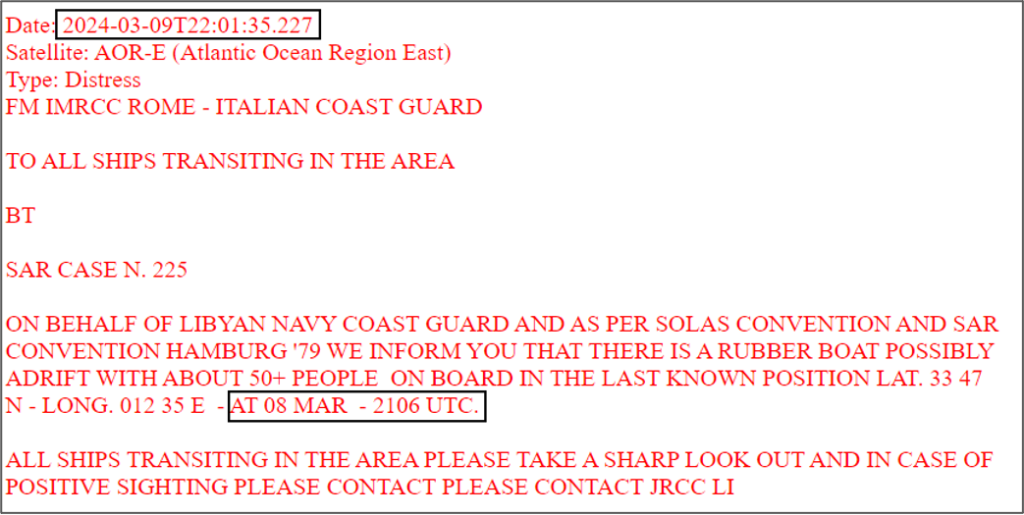
Screenshot of INMARSAT by IMRCC Rome from 15th of April, provided to Alarm Phone
The position of the rubber boat reported in the INMARSAT was slightly south of the one we had reported on the 9th March, and showed how relevant SAR authorities were already aware of the boat on the 8th of March, at 21:06 UTC (22:06 CET).
Even though the Frontex aerial surveillance asset Eagle 1 was not fully trackable, we assume that the position mentioned by IMRCC Rome in the INMARSAT was shared through the Multipurpose Aerial Surveillance System which detected the boat at 22:06 CET on the 8th of March.
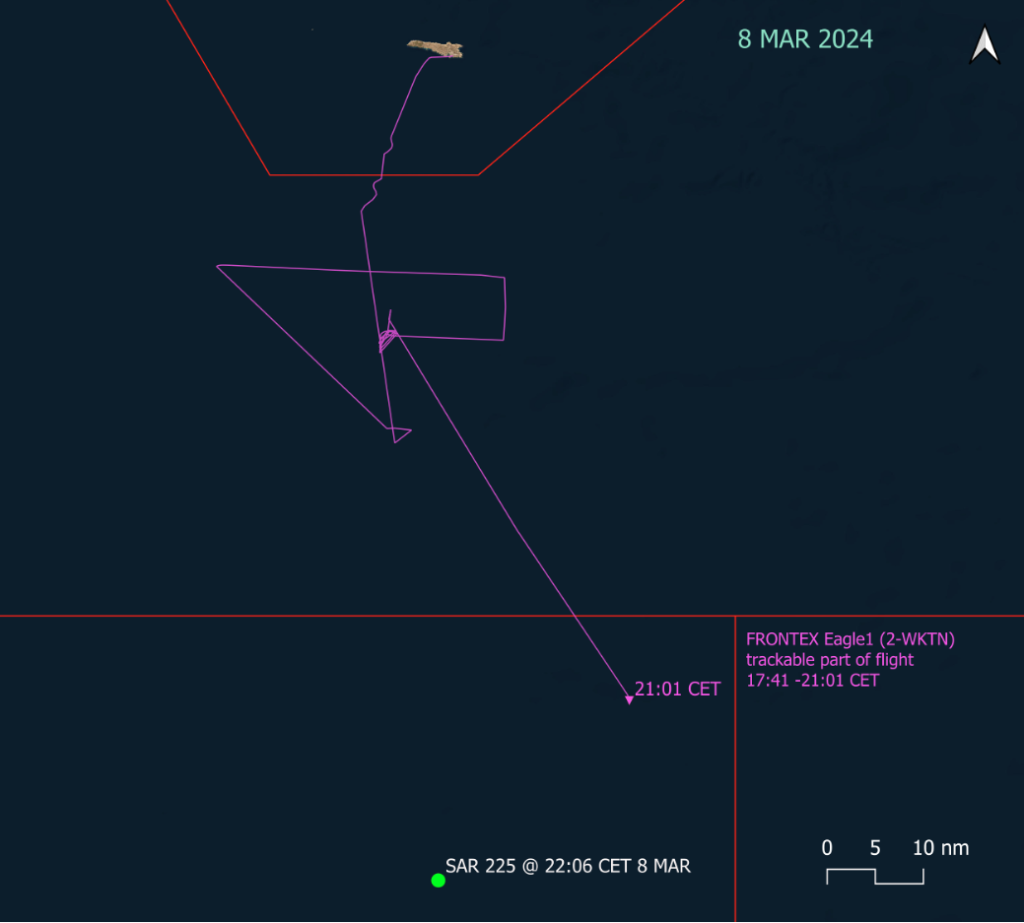
Photo: Alarm Phone
Despite having information about the boat in distress on the evening of the 8th of March, IMRCC Rome decided to withhold this information and issued the Mayday Relay only 24 hours later.
After the disembarkation of the survivors, we shortly exchanged with one survivor who remembered some more detailed information about aerial assets active in the area:
(content notion: death, suicide)
We saw a helicopter three times. Because every day for three days it came close to us, and then it always turned around and left again. We also saw drones during the night. They waved at us, there were lots of colours, red and blue. But by the time the drone reached us, the water was agitated and our engine stopped working. We also saw some small boats, they came close to us, but they too only looked at us. Because there was a small boat that came alongside us, which looked at us like this, we signalled to it, we called out to them, but they carried on. The next morning we also saw another boat that came very close to us, until we thought it was going to save us, but they too went by like that. We couldn’t even keep up with them, because the engine no longer worked.
The phone also stopped working because it fell into the water. There was water up to our knees in the boat at the time and the phone battery swelled up. Because of that we couldn’t contact you [Alarm Phone], not even our parents. Since our engine stopped working, we couldn’t even decide where we wanted to go, it was just the wind that pushed us and the waves that directed us. Even when the plane came to show us the way, we couldn’t even follow it.
And also when the drone came or the plane during the night, they circled over our boat four times and then left. We thought they might show us the way, but we couldn’t follow them because the engine wasn’t working.
What we experienced on this boat, it’s something else. Because we had no water, no food, everything was finished. We were tired, until we started drinking water, water from the sea. It’s water from the sea that we drank. A lot of people lost their lives on that boat, even a lot of my friends, because a lot of people threw themselves into the sea.
The position received by the Alarm Phone, the position relayed by IMRCC Rome, and that of the final rescue 6 days after the first reported position are all within 15 nautical miles. Since the boat continued to sail after its navigation tool broke down, it is not possible to determine the exact trajectory of the boat between the three positions.
Flight-tracking data shows Frontex’ Eagle 1 returned to fly extensive search-patterns in the same area on the 9th as well as on the 11th of March.
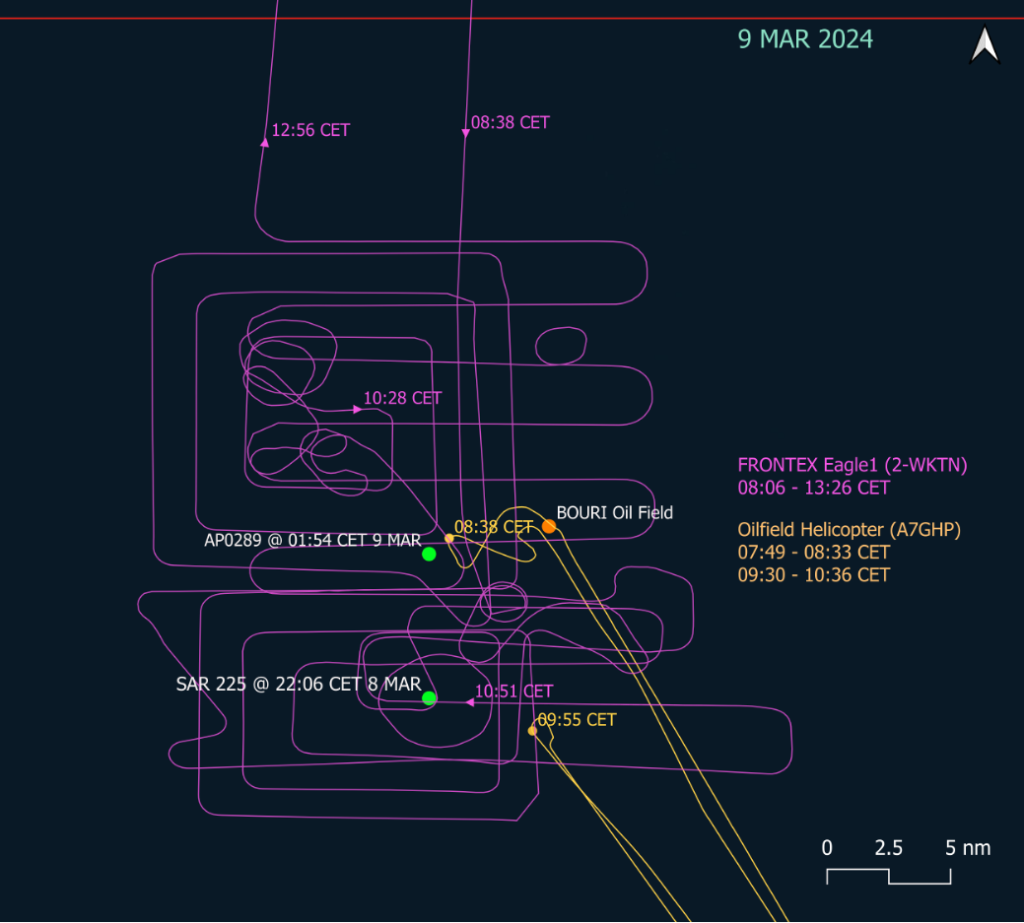
Photo: Alarm Phone
Flying such an exceptional narrow search pattern in a dedicated area strongly implicates Frontex was looking for something specific. If Eagle 1 was indeed looking for the black rubber boat it would mean Frontex knew they were not intercepted by the so-called libyan Coastguard, but still at sea.
The only trackable Helicopter in the area for the relevant days is the Oilfield Helicopter A7GHP, which is used for crew transportation between Bouri Oil Field and Tripoli. Alarm Phone called Bouri Terminal on the 9th of March, 15:04 CET informing the company about the boat and asking if they had spotted any boat, to which they answered that they had not.
On the 10th of March, Eagle 1 was flying from Lampedusa to Malta and back, without flying any search patterns, but returned to fly over the wider region on the 11th of March.
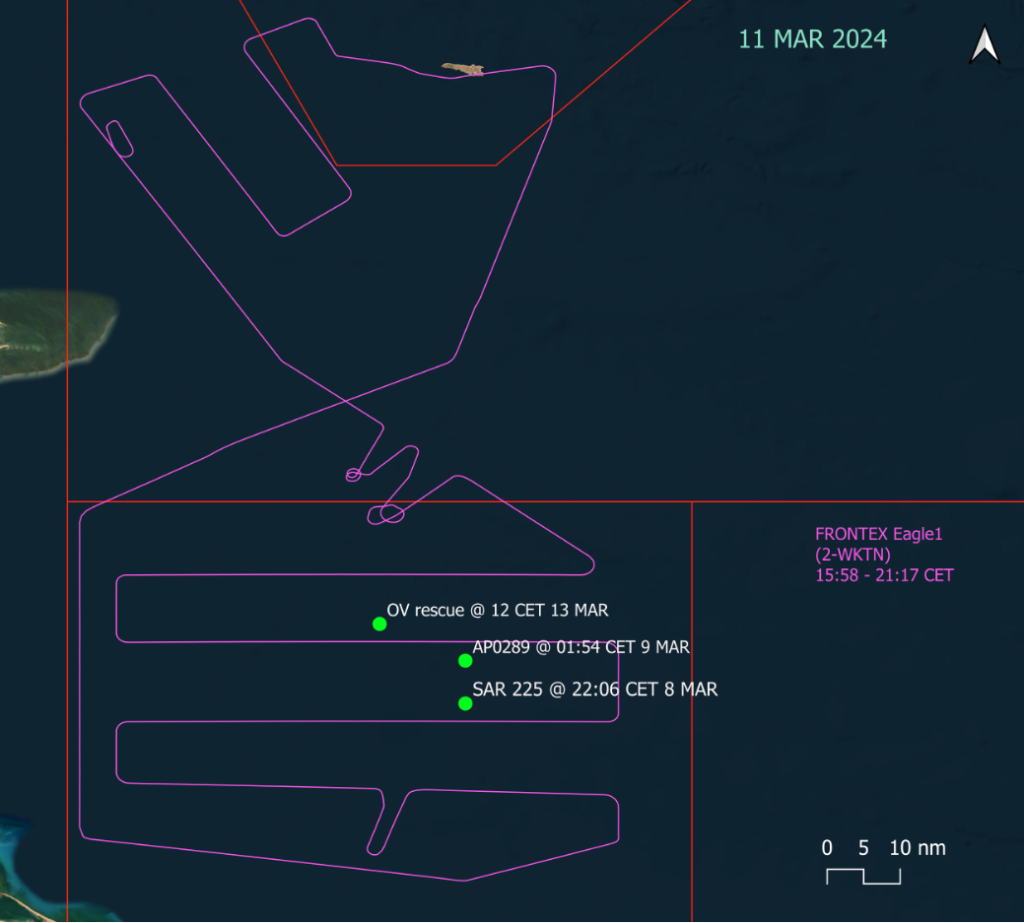
Photo: Alarm Phone
Taking into consideration the orbits of Eagle 1 on the 9th and even the 11th of March and the fact that the boat passengers saw air assets flying above them on several days, it seems highly probable that the Frontex plane came across the boat in distress at least another time, in addition to the original spotting in the evening of the 8th of March. Nonetheless, no updated information about the fate of the people on the boat nor their position was shared by FRONTEX or the IMRCC.
Frontex was asked to disclose their documentation of operations between the 8th and the 13th of March under the Freedom of Information Act. However, they denied to share any information at all, either because it was deemed to sensible to disclose or not existent at all.
Another survivor who spoke to infomigrants.com supports the statements about aerial assets in the area and remembers some more detailed information about vessels approaching the drifting rubber boat.
View this post on Instagram
The red and white ships he mentioned, sailing near the boat could be the almost identical Maridive 701 or Maridive 704, who both were very active during these six days and which, just like the crew transportation helicopter, belong to Bouri Oil field, who claimed to not have any knowledge about the boat in distress.
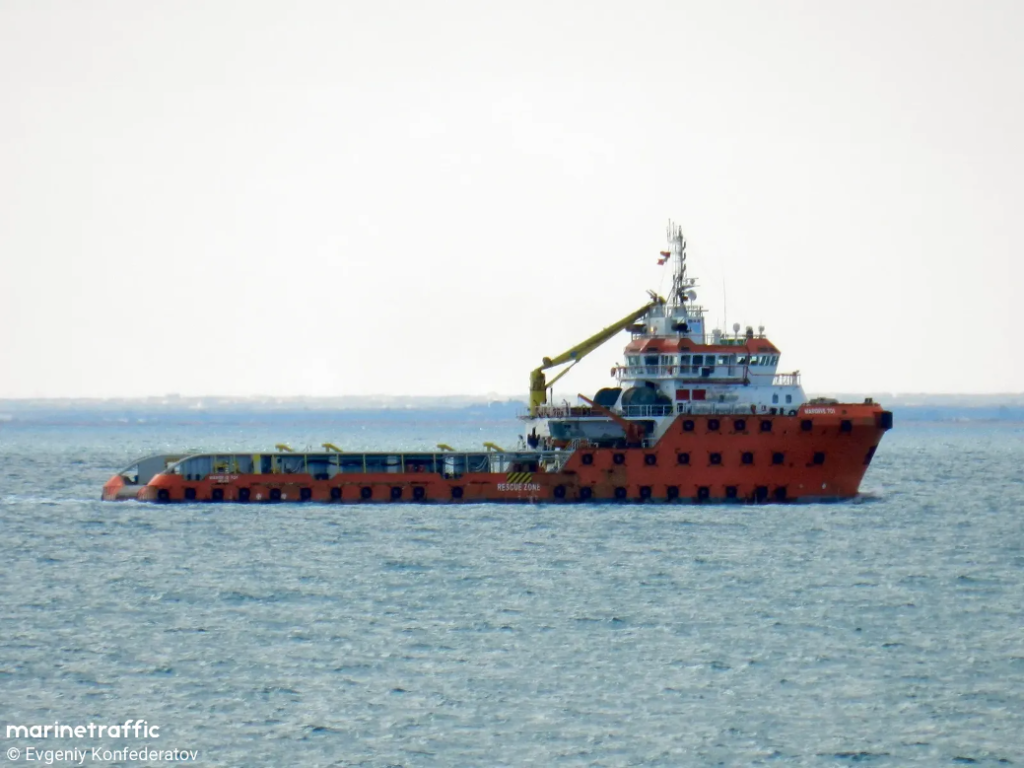
The Maridive 701. Photo: Evgeniy Konfederatov, Marine Traffic
No rescue despite active search and rescue vessel
In the morning of the 9th of March, the rescue vessel Life Support arrived in the region of the boat in distress. They were informed by Alarm Phone at the same time as IMRCC Rome, but saw little chances to find the boat with a single GPS position forwarded by a relative and not coming directly from the boat. At 10:07 CET they decided to go looking for another boat in distress more westwards near MISKAR Gas Platform, due to the scarce information available about the rubber boat. At that time, the Mayday Relay from IMRCC Rome was not yet forwarded to all ships in the area, despite IMRCC Rome most probably being informed about the boat in distress around eleven hours earlier via FRONTEX’s Eagle 1. Had they not withheld the information for so long, Life Support could have potentially rescued the boat four days earlier than Ocean Viking finally did.
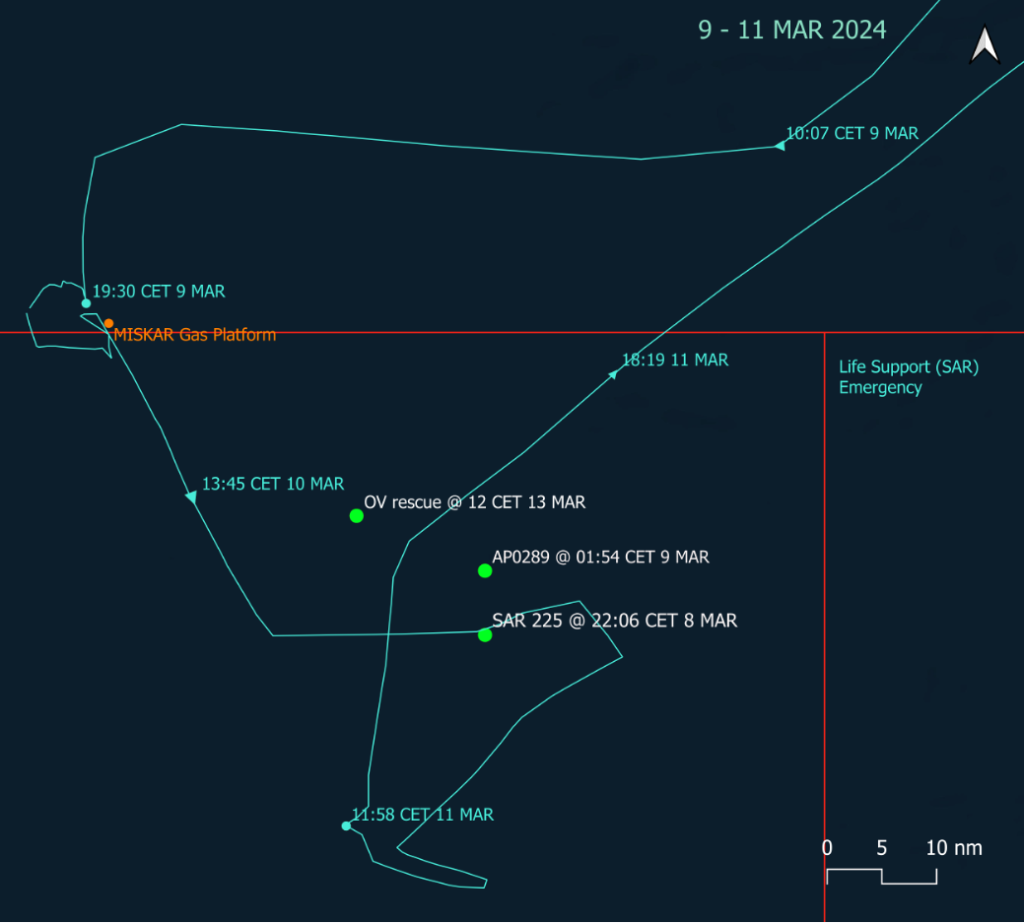
Photo: Alarm Phone
Arriving at the Miskar Gas Platform, Life Support were hindered by Tunisian Coast Guard to assist people on the move being stranded on the Platform. In the afternoon of the 10th of March, Life Support was back in the area were the rubber boat was drifting. Still without updated information, they continued further south. In the morning of the 11th of March, Life Support assisted 52 people in distress and brought them to safety in Catania on the 12th March, again crossing the region of the boat in distress, again without being able to assist the now drifting rubber boat due to lack of information.
Open questions after left-to-die-politics
According to the survivors, the drifting boat was hypervisible: On several occasions it was encountered by planes, vessels and helicopters. Frontex, IMRCC Rome, Bouri Oil platform and even the so-called Libyan Coast Guard knew about the boat, from having spotted it directly or via Alarm Phone alerts.
But again, all state-level actors decided to make use of leave-to-die policies, by holding back information, by detaining Civilian rescue ships and most of all, by not conducting a rescue despite their knowledge of the boat. Finally, after six days at sea, the boat was found accidentally by Ocean Viking, who spotted it with their binoculars.
We mourn the death of 61 lives who were killed by the nonchalance of state authorities and worry about the unimaginable trauma that survivors will have to live with. Our thoughts are with them and the families of the deceased.
In the face of this tragic event, in which 85 people were abandoned at sea and left to die, we appeal to the EU SAR authorities, the Frontex Agency and the UNHCR and ask:
- Following the sighting of the boat on the evening of 8 March, what action was taken?
- What was the assessment carried out in the European Surveillance Room in Warsaw, where, what the planes observe is shown in real time, and discussed jointly by representatives of the EU member states?
- Why did the Italian Coast Guard launch an INMARSAT only 24 hours later?
- Apart from the launch of the INMARSAT on SAR case 225, some 24 hours after the first sighting of the drifting vessel, how come none of the relevant Coast Guards launched a timely search and rescue operation?
- Was the lethal inaction we observed, and of which the death of 61 people is proof, intended to facilitate an intervention by the so-called Libyan coastguard?
- In light of recent jurisprudence which has emphasised that the Libyan authorities’ operations at sea do not fall under the heading of “rescue”, both because of the impossibility of considering Libya a port of safety and because of the latter’s structurally violent and lethal methods of intervention, how is it possible that the EU SAR authorities (IMRCC Rome and JRCC Malta) and the EU agency Frontex continue to facilitate operations at sea that are in complete contrast with international law?
- IMRCC Rome, as the first operations centre aware of the drifting boat, had a duty to monitor any action taken by the other authorities: so, once it was clear that the Libyan authorities would not intervene, how come no rescue operation was launched?
- How come merchant ships, or NGO ships in the area, were not ordered to direct themselves to the black rubber boat’s position?
- How come Frontex air assets did not launch any Mayday Relay?
We find this lack of transparency regarding the circumstances under which 85 people were abandoned at sea between the 8th and the 13th of March and left to die – despite the full knowledge of the European authorities of the situation they were in – unacceptable.
We demand truth and justice.
We stand by the people who did not survive the deadly EU external border control policies.